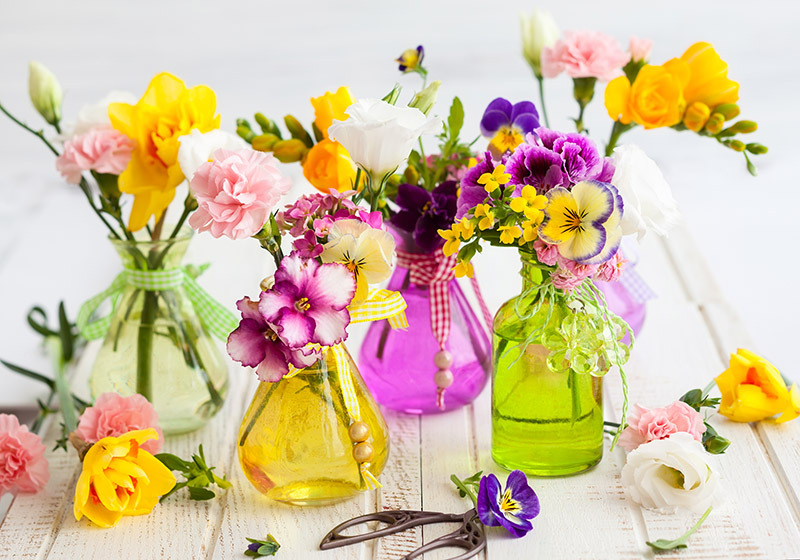Gaining Deeper Understanding Through Your Birth Flower's Symbolism
Posted on 04/07/2025
Every flower tells a story -- a vibrant language spoken through hues, fragrance, and delicate blooms. Birth flowers, much like birthstones, act as nature's gentle messengers, revealing insights about personality, destiny, and emotional ties. By gaining deeper understanding through your birth flower's symbolism, you open a portal not only to floral beauty but also to the rich tapestry of cultural, historical, and personal meanings each bloom embodies.
Why Do Birth Flowers Matter?
Just as zodiac signs and birthstones have historical and spiritual significance, birth flowers offer a unique perspective for self-reflection and connection. Assigned to each month, these blossoms go beyond mere decoration. They serve as symbols: of hope, love, transformation, and identity. By exploring the symbolism of your birth flower, you can better understand your unique traits, aspirations, and even your relationships with others and the world around you.

The Roots of Birth Flower Symbolism
The tradition of assigning flowers to months dates back centuries, with roots in ancient Rome and Victorian England. These cultures treated flowers as powerful emblems in religious rituals, courtship, and celebrations. Over time, the meaning of each birth flower crystallized, shaped by mythology, tradition, and botany.
- Ancient Roman roots:
Romans adorned homes with flowers to mark cycles, seasons, and celebrations, intertwining each flower with spiritual and calendrical significance. - Victorian language of flowers:
Known as floriography, this coded bouquet system allowed people to communicate sentiments discreetly. Every flower carried its own "dictionary." - Eastern traditions:
In Japan, hanakotoba -- the language of flowers -- is woven into everyday life, expressing deeper emotions and social intentions.
Exploring Every Month's Birth Flower Symbolism
Understanding what your birth flower symbolizes can be a window into your personal narrative. Here, we break down each month's flower and unpack the web of meanings they represent.
January: Carnation & Snowdrop
Carnation: Love, fascination, distinction, and resilience. Carnations, blooming in the heart of winter, symbolize undying love and unwavering resolve. Their ruffled petals represent hidden layers of character.
Snowdrop: Hope and rebirth. Pushing through frost, snowdrops signal the promise of spring, making them emblems of hope and purity.
February: Violet & Primrose
Violet: Modesty, faithfulness, and humility. With their understated beauty, violets reflect quiet strength and a steadfast spirit.
Primrose: Youth, renewal, and new beginnings. Primroses are among the first spring flowers, highlighting themes of optimism and fresh starts.
March: Daffodil
Daffodil: Rebirth, new beginnings, and prosperity. As harbingers of spring, daffodils stand for hope, joy, and bright tomorrows.
April: Daisy & Sweet Pea
Daisy: Innocence, purity, and loyal love. Daisies, with their unassuming beauty, evoke simplicity and sincerity.
Sweet Pea: Blessed pleasure and gratitude. This delicate, fragrant flower symbolizes cherished memories and goodbyes.
May: Lily of the Valley & Hawthorn
Lily of the Valley: Humility, chastity, and happiness. Known for its gentle fragrance, it represents a return to good fortune and pure joy.
Hawthorn: Hope and supreme happiness. As the "May tree," hawthorn marks happiness and protection.
June: Rose & Honeysuckle
Rose: Love, balance, and passion. Depending on color, roses symbolize everything from deep love to friendship and remembrance.
Honeysuckle: Devoted affection and sweet disposition. With its heady scent, honeysuckle expresses everlasting bonds.
July: Larkspur & Water Lily
Larkspur: Positivity, dignity, and open heart. Larkspur's towering blooms denote lightness and joy.
Water Lily: Purity, enlightenment, and rebirth. Floating serenely, it connects water's depths with the tranquility of the surface.
August: Gladiolus & Poppy
Gladiolus: Strength of character, sincerity, and remembrance. With their sword-like leaves, they suggest moral integrity and courage.
Poppy: Imagination, consolation, and eternal sleep. Poppies evoke both artistry and remembrance, especially for those lost.
September: Aster & Morning Glory
Aster: Wisdom, faith, and valor. Named for the Greek word for "star," asters symbolize guidance and elegance.
Morning Glory: Affection and tenacity. They bloom in the early light, reminding us to cherish fleeting beauty.
October: Marigold & Cosmos
Marigold: Warmth, creativity, and passion. The vibrant hue of marigolds reflects strength and the transformative power of sunlight.
Cosmos: Harmony, order, and peace. Cosmos suggests tranquility and the balance of the universe.
November: Chrysanthemum
Chrysanthemum: Loyalty, friendship, and optimism. In many cultures, these blooms are imbued with meaning--regarded as symbols of cheerfulness and life.
December: Narcissus & Holly
Narcissus: Faithfulness, good wishes, and renewal. The narcissus represents the spirit of hope and the celebration of new beginnings.
Holly: Protection and domestic happiness. Its evergreen leaves symbolize the continuity of life.
How to Connect With Your Birth Flower's Symbolism
Delving into your personal birth flower symbolism is about more than identification--it's a journey toward self-awareness and harmony. Below are ways to explore your own connection:
- Self-Reflection: Meditate on the traits and qualities associated with your birth flower. Do these resonate with your personal story, strengths, or aspirations?
- Create a Ritual: Incorporate your birth flower into your daily life. This could include fresh bouquets, pressed blooms, aromatherapy, or even digital wallpapers.
- Share the Symbolism: Gift your birth flower or its image to loved ones, sharing the unique meaning behind the gesture.
- Journaling: Document moments when you notice similarities with your flower, linking symbolism to specific experiences or decisions.
- Art and Decor: Express your connection through painting, floral crafts, or home decor highlighting your birth flower.
Birth Flower Symbolism in Culture and Myth
The legends, stories, and customs surrounding birth flower meanings add another layer of connection. For example:
- In Greek mythology, the narcissus flower is tied to the story of Narcissus, symbolizing self-reflection and renewal.
- Roses are sacred in Roman and Christian contexts, used as symbols of love, secrecy, and martyrdom.
- In Japanese culture, the chrysanthemum is honored as the symbol of the Emperor and the Imperial family, signifying rejuvenation and longevity.
- The Victorian era popularized using flowers as secret messages, with the meaning of each bloom carefully chosen to create nuanced, layered expressions of emotion and thought.
How to Use Birth Flower Symbolism in Daily Life
Besides personal reflection, integrating birth flower symbolism into your lifestyle can be uplifting and inspiring. Here are some practical ideas:
- Floral Jewelry: Wear pendants, brooches, or rings in the shape of your birth flower to carry its energy with you.
- Gifting: Giving someone a bouquet imbued with the sentiment of their birth flower can mark birthdays or celebrate milestones in an especially meaningful way.
- Gardening: Plant your birth flower in your home or garden to cultivate harmony and connection to the natural world.
- Meditation and Affirmation: Incorporate the qualities of your birth flower into personal affirmations and meditative practices for empowerment.
Frequently Asked Questions About Birth Flower Symbolism
- What if my birth month has more than one flower?
Many months, such as April and December, have alternate birth flowers. Each offers distinct symbolism--you can embrace both or choose the one that best resonates with you. - Can I resonate with another month's flower?
Absolutely. While traditional birth flowers offer guidance, you are free to connect with any bloom that speaks to your heart and spirit. - Are there negative associations?
Most birth flower meanings are positive, centering on virtues like loyalty, love, hope, and strength. Even flowers with somber connotations, like the poppy (remembrance), are balanced by the promise of comfort and beauty.

The Deeper Message of Birth Flower Symbolism
To gain a deeper understanding through your birth flower's symbolism is to recognize the universal need for meaning, connection, and beauty. Flowers stand as reminders that even the most delicate things can hold profound stories--and that by paying attention to these natural symbols, we can uncover insights about ourselves and our lives.
Whether you wear a rose for love, plant a daffodil for hope, or simply gaze at a chrysanthemum for cheer, the world of birth flower symbolism invites you to celebrate your individuality and find harmony within your natural surroundings.
Conclusion: Let Your Birth Flower Speak
Gaining deeper understanding through your birth flower's symbolism is more than a poetic gesture--it's a way to connect intimately with your heritage, your inner strengths, and the subtle magic of the natural world. Allow your birth flower to inspire self-awareness, fuel personal growth, and enrich daily living with layers of meaning that blossom anew in every season.
Latest Posts
A Dozen Long-Lasting Blooms for the Enthusiast
Fragrant Therapy: Boosting Your Mood with Floral Beauty
Master the Art of Hydrangea Care for Stunning Garden Views
The Enchanting Allure of Red Roses on Valentine's Day
Gaining Deeper Understanding Through Your Birth Flower's Symbolism





